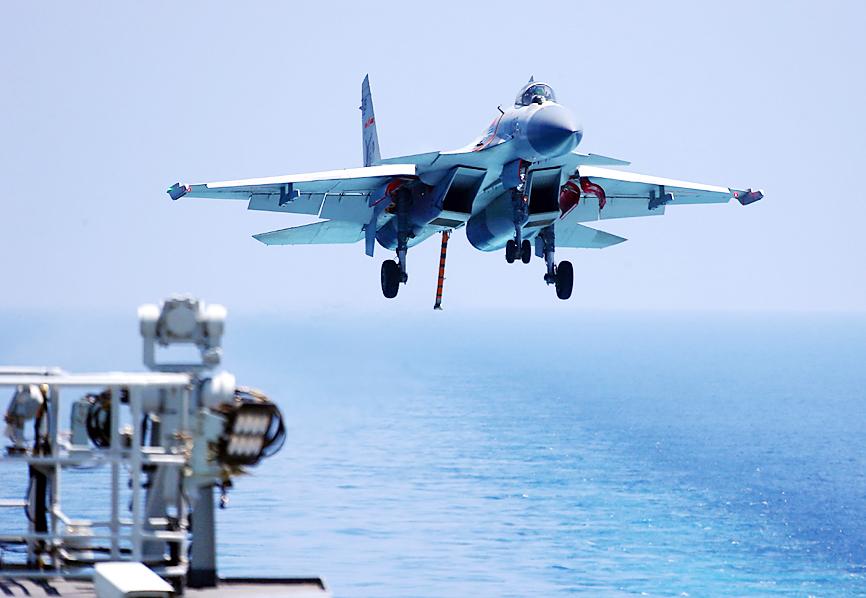Taiwan has laid out plans to challenge what it described as China’s “gray zone threats” to shift the balance of power in the region and possibly take over the nation without fighting a battle.
The Ministry of National Defense yesterday outlined in a biennial military strategy report how it aims to counter what it describes as Beijing’s pressure campaign.
It cited warplane incursions, as well as speedboats ramming its coast guard vessels, and accused China of engaging in “cognitive warfare” to sway Taiwanese public opinion.

Photo: AFP
The military is committed to protecting Taiwan’s sovereignty and democratic system, the ministry said, laying out its strategy for countering China.
“The first and foremost defense undertaking is to prevent war and deter any external military threats, and our overall defense power shall be employed to defend our homeland, magnify the costs and risks entailed by the [People’s Republic of China’s] invasion, and ultimately protect the lives and properties of the people,” it said.
Taiwan has re-emerged as a flash point in US-China ties in the past few months. Washington has been moving to help the government in Taipei take on a bigger role in international organizations like the UN, and US President Joe Biden said last month that the US would come to Taiwan’s aid if it was attacked by China — comments the White House later said did not mark a change in policy.
Yesterday’s report lays out how the military plans to expand the range of its military deterrence to the Chinese coast to create “hostile” embarking and seafaring phases for the Chinese People’s Liberation Army (PLA) forces should they attempt to cross the Taiwan Strait.
“The PLA’s weakness is in the phase of sea transit,” the report said. “The Armed Forces must take full advantage of the natural barrier of the Taiwan Strait and fight in a resilient manner.”
“We should not limit ourselves to waiting for the enemy’s landing groups to sail through the Strait, but should also use measures to force the enemy to assemble forces at airfields or ports further away from areas opposite Taiwan,” it said.
Given China’s overwhelming superiority in terms of personnel and resources, Taiwan plans to utilize asymmetric tactics to nullify the PLA’s advantages, such as countering Chinese airborne operations with mobile surface-to-air missiles and attacking large ships with small, fast and resilient vessels, the report said.
Defensive cruise missiles, and land and sea mines would be key platforms to deter a Chinese attempt to land on Taiwan, it said.
President Tsai Ing-wen (蔡英文) last month told CNN that she was confident the US would come to Taiwan’s defense if China tried to invade, adding that the “threat from China is increasing every day,” while also confirming the presence of some US troops in Taiwan.

STILL COMMITTED: The US opposes any forced change to the ‘status quo’ in the Strait, but also does not seek conflict, US Secretary of State Marco Rubio said US President Donald Trump’s administration released US$5.3 billion in previously frozen foreign aid, including US$870 million in security exemptions for programs in Taiwan, a list of exemptions reviewed by Reuters showed. Trump ordered a 90-day pause on foreign aid shortly after taking office on Jan. 20, halting funding for everything from programs that fight starvation and deadly diseases to providing shelters for millions of displaced people across the globe. US Secretary of State Marco Rubio, who has said that all foreign assistance must align with Trump’s “America First” priorities, issued waivers late last month on military aid to Israel and Egypt, the

France’s nuclear-powered aircraft carrier and accompanying warships were in the Philippines yesterday after holding combat drills with Philippine forces in the disputed South China Sea in a show of firepower that would likely antagonize China. The Charles de Gaulle on Friday docked at Subic Bay, a former US naval base northwest of Manila, for a break after more than two months of deployment in the Indo-Pacific region. The French carrier engaged with security allies for contingency readiness and to promote regional security, including with Philippine forces, navy ships and fighter jets. They held anti-submarine warfare drills and aerial combat training on Friday in

COMBAT READINESS: The military is reviewing weaponry, personnel resources, and mobilization and recovery forces to adjust defense strategies, the defense minister said The military has released a photograph of Minister of National Defense Wellington Koo (顧立雄) appearing to sit beside a US general during the annual Han Kuang military exercises on Friday last week in a historic first. In the photo, Koo, who was presiding over the drills with high-level officers, appears to be sitting next to US Marine Corps Major General Jay Bargeron, the director of strategic planning and policy of the US Indo-Pacific Command, although only Bargeron’s name tag is visible in the seat as “J5 Maj General.” It is the first time the military has released a photo of an active

CHANGE OF MIND: The Chinese crew at first showed a willingness to cooperate, but later regretted that when the ship arrived at the port and refused to enter Togolese Republic-registered Chinese freighter Hong Tai (宏泰號) and its crew have been detained on suspicion of deliberately damaging a submarine cable connecting Taiwan proper and Penghu County, the Coast Guard Administration said in a statement yesterday. The case would be subject to a “national security-level investigation” by the Tainan District Prosecutors’ Office, it added. The administration said that it had been monitoring the ship since 7:10pm on Saturday when it appeared to be loitering in waters about 6 nautical miles (11km) northwest of Tainan’s Chiang Chun Fishing Port, adding that the ship’s location was about 0.5 nautical miles north of the No.